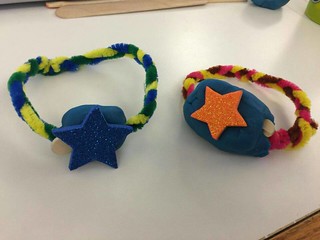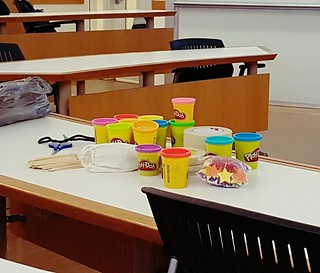 This week we were fortunate to have members of Design for America from the UIUC Chapter present a workshop. It was a fantastic presentation in which we not only learned more about the RSO and their projects, but also participated in a series of interactive activities in groups in which eventually each group designed a prototype to solve a specific problem. As a class, we were given the prompt to come up with a system that could make daily lives easier for senior citizens. My group narrowed the topic down to specifically help the elderly when they are by themselves, especially in situations like falling. This idea stemmed from the fact that some of our team members have personal experiences of older relatives falling but weren’t able to get immediate help because they were home alone. Eventually, we designed a Fitbit-like bracelet which could sense emergency situations such as sudden drops or irregularities in the wearer’s heart rate and alert the person’s family members. This will ensure people get the help they need during accidents.
This week we were fortunate to have members of Design for America from the UIUC Chapter present a workshop. It was a fantastic presentation in which we not only learned more about the RSO and their projects, but also participated in a series of interactive activities in groups in which eventually each group designed a prototype to solve a specific problem. As a class, we were given the prompt to come up with a system that could make daily lives easier for senior citizens. My group narrowed the topic down to specifically help the elderly when they are by themselves, especially in situations like falling. This idea stemmed from the fact that some of our team members have personal experiences of older relatives falling but weren’t able to get immediate help because they were home alone. Eventually, we designed a Fitbit-like bracelet which could sense emergency situations such as sudden drops or irregularities in the wearer’s heart rate and alert the person’s family members. This will ensure people get the help they need during accidents.

This workshop allowed us to create something using a very systematic approach. It was interesting because rather than chaotic free-thinking, we were purposely forced to break down the problem and go through individual steps (“Inspiration, Ideation, Implementation” as Tim Brown mentioned in his article Design Thinking) that eventually led to a solution. However, this type of approach did not hinder our creativity. Instead, it allowed us to utilize low-fidelity prototyping in which we openly generated ideas without discarding any right away. At the same time, this process made us think through each of their feasibilities. It also made me realize that by brainstorming problems in our lives, discussing with others, and using simple, supposedly “childish” tools such as markers, Play-Doh, and pipe cleaners, we were able to develop ideas that could potentially become a powerful contribution to the society.
As said in the article Design Thinking and videos from the Coursera Online Course, in today’s society, professional designers aren’t the only ones that design. Big corporations, companies, organization, and people like you and me should be involved in the design process. Innovation is not just limited to producing aesthetically pleasing physical products, but rather it expands into the realm of IT processes and collaboration. This leads to the idea, which was also mentioned during DFA’s presentation, of human-centric design. It’s very important to factor in human needs when designing. In addition, it’s essential to not shy away from complexity or ambiguity and be willing to fail, as mentioned in the videos. The famous IDEO shopping cart design documentary is a great example of how people (and not just designers) with all sorts of backgrounds come together and create something using the human-centric design. The shopping trolleys with multiple handles for bags make it easy for shoppers who are only picking up a few items. These trolleys can also hold baskets for those who need more space. Also, an article I found to be interesting is How to use human centric knowledge to your advantage by Robert Leeming, which explains how learning about the interactions between lighting and the human circadian rhythm could help us increase efficiency in the workplace and improve patients’ health in hospitals. And think about how neat it would be if lighting itself could fix jet lags!
To sum it up, when we look at problems today like unaffordable healthcare, poor education system, and poverty, it’s clear that these issues require creative, human-centered solutions, which can be developed through inspiration, ideation, and implementation, because ultimately, people are the ones the system serves.



Hi Tiffany,
I really like the idea that your team came up with, and the bracelet model looks cool. I agree with you on the topic of using human centric ways as a possible solution in solving the hard problems. One project I’ve noticed is the a nursing home designed for senior citizens suffering from alzheimer’s disease, and I think it is very close to what we’ve discussed. I believe people are trying to make similar kind of effort and hopefully we can see some other proposals in the future.
Hey Tiffany,
For one thing, working with you and getting to know you have been great! I love how you mentioned how humans need design and that almost all object we own has some form of design. I believe that sometimes we take designs and the innovations behind them for granted. For example, take a simple salt shaker, we might not think much about it, but there was a time where the salt shaker was an innovative creation that helped moderate the amount of salt you were using.
Hi Tiffany,
I think you did a good job characterizing the main aspects of the Design for America presentation. Your project for the presentation that tackles potential accidents and alerts family members seems very feasible since Fitbit already makes bracelets that can detect heart rate and so to connect that to the web and alert family members and caregivers is a great idea. I think the process of reiteration is extremely important as one can’t determine the flaws without first trying to get a comprehensive idea of the product and solution. I especially liked your IDEO shopping cart example as it focused on human-centered design, which is a large part of design thinking nowadays.
Cheers!
Hi Tiffany,
Great post, and you definitely bring up some thought-provoking points on the ideating process. As the Design for America presenters briefly mentioned, it is easy to get caught up in the granular, nitty-gritty aspects of a product which can cause the process to be marred in delays and indecisiveness. Rather, it can be quite useful to develop an initial prototype and continue to improve the product through multiple iterations as issues arise. The article by Robert Leeming also was incredibly interesting, as it incorporates a degree of psychology into the mix.